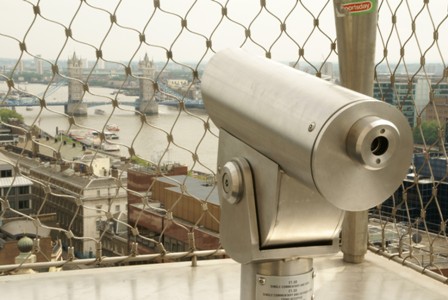I wandered over to The Monument after my visit to St. Paul’s Cathedral. Apparently, going up, then down the 528 stairs at the church wasn’t enough of a challenge for my leg muscles — why not tack on 311 more steps?

Like St. Paul’s, the Monument was also designed by Sir Christopher Wren. It was completed in 1677 to commemorate the Great Fire of London, which 11 years earlier destroyed most of the homes and businesses in the city at that time. The Monument was built near the spot where that fire began, at Thomas Farriner’s bakery on Pudding Lane.

It’s no surprise what you’ll find inside the Monument’s column: a tight spiral of stairs, that spins its way to the viewing platform, near the top of the 202-foot-tall memorial.

The platform is caged-in, thanks to a few suicides, more than a century ago. Even with the wire netting over the platform, you’ll still get a nice view of the Tower Bridge…

… the downtown skyscrapers…

… and the endless stream of double-decker buses that are chugging along through the city.

Looking up, you can see the flaming orb that crowns the top of the Monument.

It was restored during an 18-month refurbishment project, which was completed in 2009. The project included applying 30,000 pieces of gold leaf to the flames and orb.

Once you’ve gawked at the city skyline for a few minutes, you must once again tackle the 311 winding stairs that will take you back down to the street. Look straight down for a dizzying view of the spiral.
The Monument’s central shaft served more than one purpose. In addition to housing the stairs, it also could be used as a zenith telescope, and for pendulum and gravity experiments (the pendulum would dangle into a laboratory, underground. Also, each step is six inches high, which allows the entire tower to be used as a giant measuring stick, in barometric pressure experiments.†

Also, before you start your descent, look on the inside walls of the monument for some inscriptions, dating back more than 200 years.





No comments